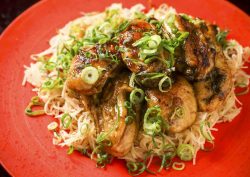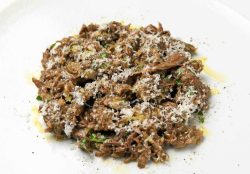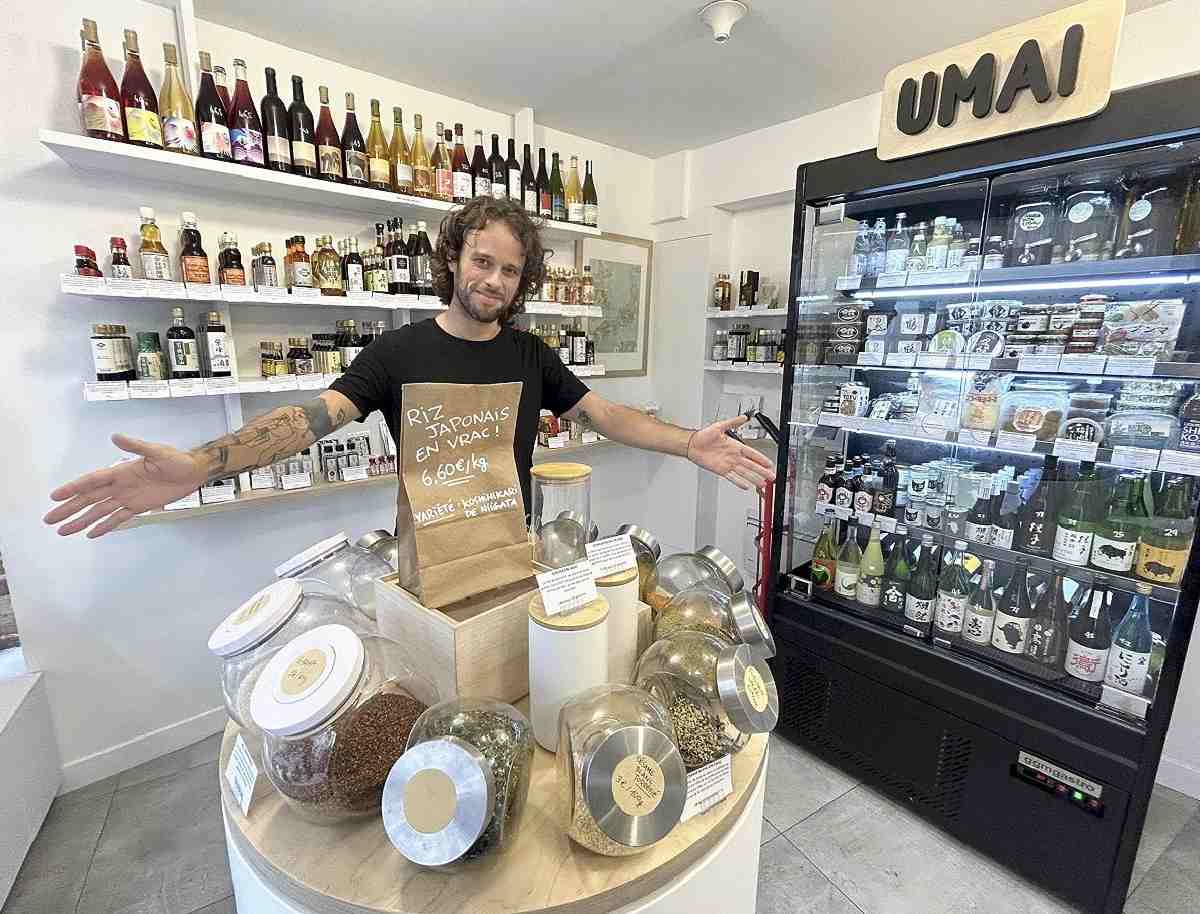
Sebastien Wesolowski, the owner of Epicerie Umai, stands near Japanese condiments and seasonings, among other items, in Paris on Sept. 29, 2023.
15:30 JST, February 4, 2024
Atsuko Ikeda, a cooking specialist based in London, held a Japanese home cooking class and taught the group how to make mizutaki hot pot from Fukuoka Prefecture, kakuni braised pork from Nagasaki Prefecture and other dishes from the Kyushu region, where she is from.
The eight students prepared the dishes and ate them while sampling shochu one evening in late November in the city.
“Some of the dishes were new to me,” said Steve Fallon, 70, a guidebook writer. “I really enjoyed them.”
The following week, Fallon made mizutaki at home using a portable stove and ate it with his family.
Fallon enjoys washoku (Japanese cuisine) and first took Ikeda’s class in 2009 so he could cook more for his family. He became interested in the tastes and the beautiful arrangement of Japanese food and has even taken classes in preparing bento lunch boxes and vegan cooking based on Buddhist teachings.
Fallon, who is originally from Boston, said his love of fish is another reason why he was drawn to Japanese cuisine.
At home, he has a shelf lined with soy sauce, mirin and other Japanese condiments and can cook such dishes as renkon tsukune (meatballs using lotus root), chawan mushi (savory steamed egg custard) and nikujaga (meat and potato stew).
Fallon said that Japanese food has a variety of flavors and its umami is very unique.
Ikeda, 48, said, “More and more people want to make Japanese food themselves and understand it better.”
During her classes, Ikeda explains “gomi, goshoku, goho,” which translates to five tastes, five colors and five methods of Japanese cooking.
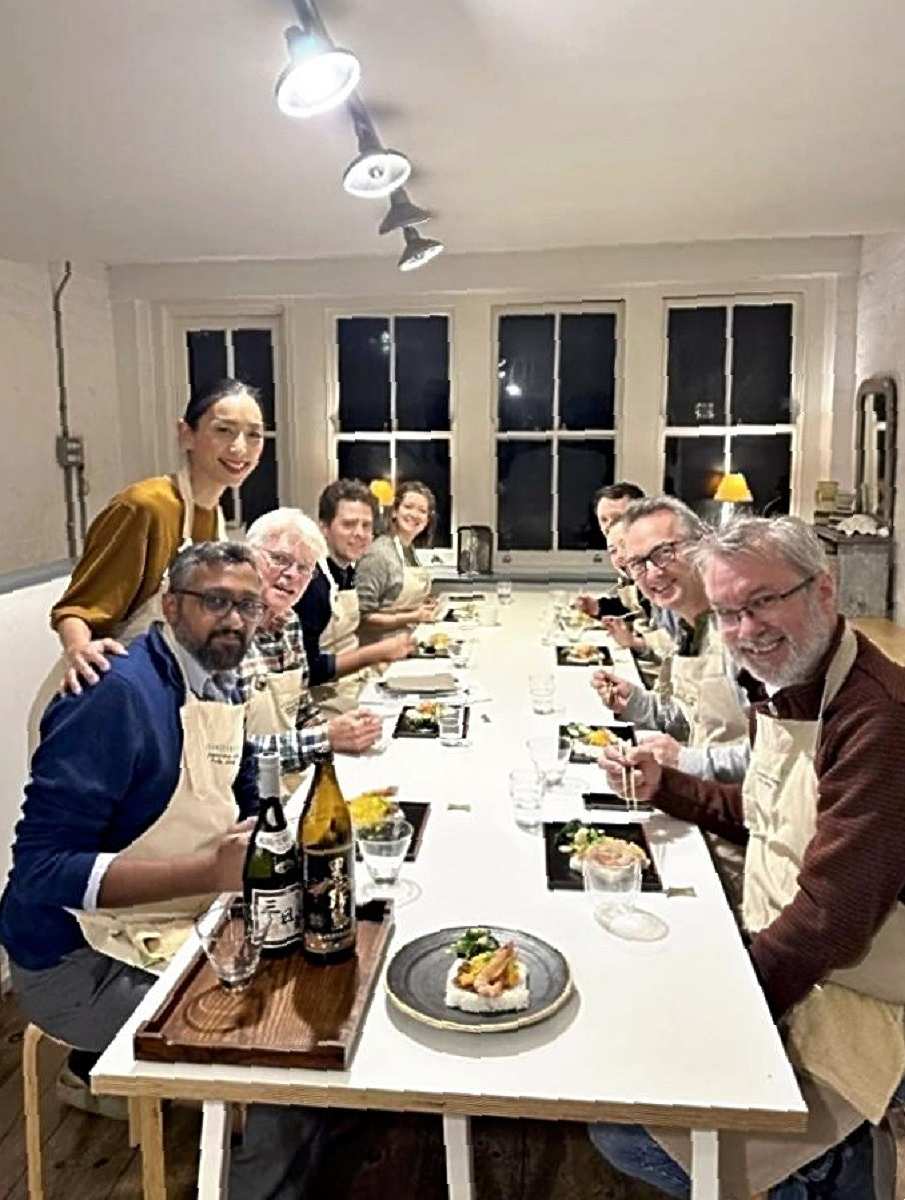
Atsuko Ikeda, standing, poses with her Japanese home cooking class, which includes Steve Fallon, second from left, as the students try sukozushi, a type of sushi from Saga Prefecture.
In Paris, Japanese ingredients are becoming more readily available as Japanese markets are opening in the suburbs as well.
Epicerie Umai, which opened in 2022 in northeastern Paris, sells such ingredients as soy sauce, vinegar, konbu, dried bonito flakes, umeboshi (pickled plums) and natto (fermented soybeans).
“More people have become interested in cooking Japanese food at home,” said Sebastien Wesolowski, 32, who owns the store. “They not only make rice and miso soup, but also nukazuke, [pickled vegetables that have been fermented in rice bran and brine], among other things.”
A 50-year-old local resident, makes miso soup, shogayaki, which is ginger-flavored stir-fried meat, and other Japanese dishes at home. His miso soup contains such ingredients as leeks, shiitake and turnips.
He said that Japanese meals are healthy and nutritionally balanced, especially the traditional combination of soup and three dishes.
Keiichiro Miyagawa, 61, who is familiar with the status of Japanese food in Paris and conducts research for The Japan Food Product Overseas Promotion Center, said: “People used to have to go to restaurants to eat Japanese food, but now they can easily buy cooked dishes at supermarkets. Ingredients have become more readily available and cooking Japanese food at home has become easier.”
Taking classes
Tokyo-based ABC Cooking Studio, a school that teaches students how to prepare Japanese cuisine, expanded its business overseas in 2010. The company currently has 36 locations in eight countries and regions, including China and Thailand. In 2022, about 110,000 people attended the classes.
In addition to its 12-class courses, the company also offers one-time classes, including one that teaches students how to make onigiri rice balls.
Recipes are changed to adjust flavors to suit local tastes or to comply with halal food regulations in certain countries.
“I liked making udon noodles from scratch using flour and water,” said a 39-year-old woman, who has been taking classes at a studio in Singapore for the past four years. “I want to try making it at home.”
With more videos online showing viewers how to make Japanese food and more cookbooks translated into English, it has provided more opportunities for people to learn about washoku Japanese cuisine.
“Against the backdrop of people becoming more health conscious, after trying Japanese food at restaurants and as takeout, preparing Japanese food at home will likely become more common.”
Jump in tofu exports
Japanese ingredients are also gaining attention overseas as plant-based foods in particular are becoming more popular as a result of increased environmental awareness and people trying a vegetarian diet.
There is also an increase in tofu exports to the United States, and it is often eaten as a substitute for meat or fish. Firm tofu is more popular, but a wide range of firmness levels and flavors of tofu can be found in supermarkets in the United States.
Konnyaku, a jellylike food made of konjac potato, is another ingredient that is becoming more in demand.
According to the Gunma prefectural government, which is promoting the export of konnyaku, using the food to make noodles as a substitute for pasta and ramen noodles is on the rise. Making konnyaku rice and konnyaku jerky is also being developed.
"Features" POPULAR ARTICLE
-

Sanrio to Open Museum in Yamanashi Pref. Dedicated to Founder, Exhibits Include Hello Kitty, Other Characters
-
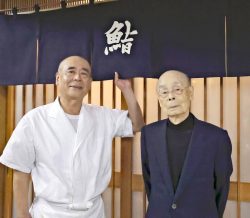
Legendary Sushi Chef Jiro Ono Turns 100: ‘I Have No Regrets’
-

Autumn Foliage Surrounds Visitors to Tokyo’s Showa Kinen Park
-

My Daughter No Longer Speaks to Me, But I Want to See Her and My Grandchild
-

Kumamoto: Public Bath Refurbished as Library Where You Can Chat, Take Photos
JN ACCESS RANKING
-

Keidanren Chairman Yoshinobu Tsutsui Visits Kashiwazaki-Kariwa Nuclear Power Plant; Inspects New Emergency Safety System
-

Imports of Rare Earths from China Facing Delays, May Be Caused by Deterioration of Japan-China Relations
-

University of Tokyo Professor Discusses Japanese Economic Security in Interview Ahead of Forum
-

Japan Pulls out of Vietnam Nuclear Project, Complicating Hanoi’s Power Plans
-

Govt Aims to Expand NISA Program Lineup, Abolish Age Restriction




